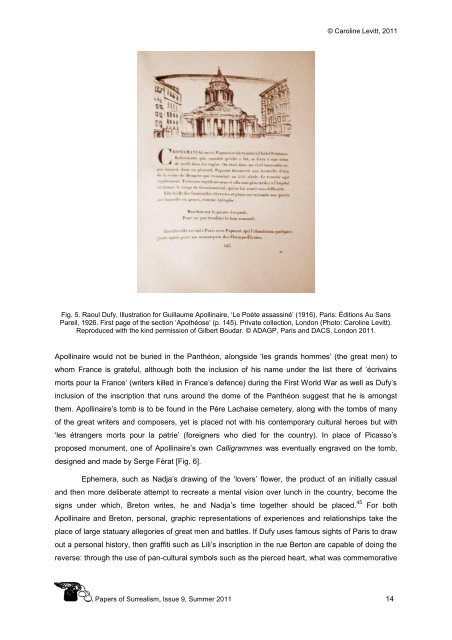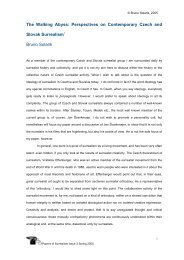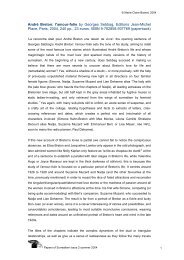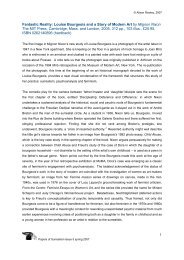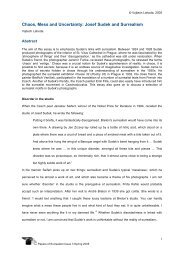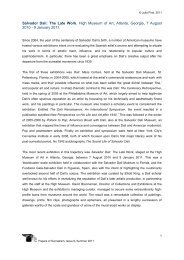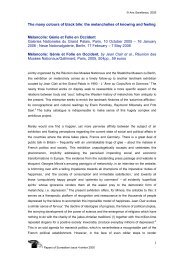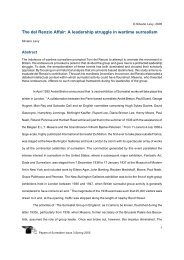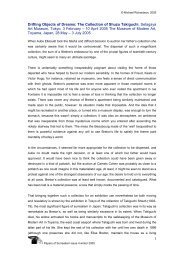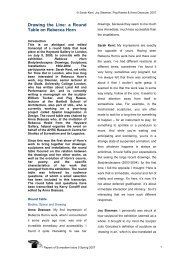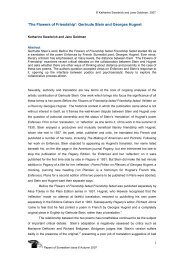From the Walls of Factories to the Poetry of the Street: Inscriptions ...
From the Walls of Factories to the Poetry of the Street: Inscriptions ...
From the Walls of Factories to the Poetry of the Street: Inscriptions ...
Create successful ePaper yourself
Turn your PDF publications into a flip-book with our unique Google optimized e-Paper software.
© Caroline Levitt, 2011<br />
Fig. 5. Raoul Dufy, Illustration for Guillaume Apollinaire, „Le Poète assassiné‟ (1916), Paris: Éditions Au Sans<br />
Pareil, 1926. First page <strong>of</strong> <strong>the</strong> section „Apothéose‟ (p. 145). Private collection, London (Pho<strong>to</strong>: Caroline Levitt).<br />
Reproduced with <strong>the</strong> kind permission <strong>of</strong> Gilbert Boudar. © ADAGP, Paris and DACS, London 2011.<br />
Apollinaire would not be buried in <strong>the</strong> Panthéon, alongside „les grands hommes‟ (<strong>the</strong> great men) <strong>to</strong><br />
whom France is grateful, although both <strong>the</strong> inclusion <strong>of</strong> his name under <strong>the</strong> list <strong>the</strong>re <strong>of</strong> „écrivains<br />
morts pour la France‟ (writers killed in France‟s defence) during <strong>the</strong> First World War as well as Dufy‟s<br />
inclusion <strong>of</strong> <strong>the</strong> inscription that runs around <strong>the</strong> dome <strong>of</strong> <strong>the</strong> Panthéon suggest that he is amongst<br />
<strong>the</strong>m. Apollinaire‟s <strong>to</strong>mb is <strong>to</strong> be found in <strong>the</strong> Père Lachaise cemetery, along with <strong>the</strong> <strong>to</strong>mbs <strong>of</strong> many<br />
<strong>of</strong> <strong>the</strong> great writers and composers, yet is placed not with his contemporary cultural heroes but with<br />
„les étrangers morts pour la patrie‟ (foreigners who died for <strong>the</strong> country). In place <strong>of</strong> Picasso‟s<br />
proposed monument, one <strong>of</strong> Apollinaire‟s own Calligrammes was eventually engraved on <strong>the</strong> <strong>to</strong>mb,<br />
designed and made by Serge Férat [Fig. 6].<br />
Ephemera, such as Nadja‟s drawing <strong>of</strong> <strong>the</strong> „lovers‟ flower, <strong>the</strong> product <strong>of</strong> an initially casual<br />
and <strong>the</strong>n more deliberate attempt <strong>to</strong> recreate a mental vision over lunch in <strong>the</strong> country, become <strong>the</strong><br />
signs under which, Bre<strong>to</strong>n writes, he and Nadja‟s time <strong>to</strong>ge<strong>the</strong>r should be placed. 45 For both<br />
Apollinaire and Bre<strong>to</strong>n, personal, graphic representations <strong>of</strong> experiences and relationships take <strong>the</strong><br />
place <strong>of</strong> large statuary allegories <strong>of</strong> great men and battles. If Dufy uses famous sights <strong>of</strong> Paris <strong>to</strong> draw<br />
out a personal his<strong>to</strong>ry, <strong>the</strong>n graffiti such as Lili‟s inscription in <strong>the</strong> rue Ber<strong>to</strong>n are capable <strong>of</strong> doing <strong>the</strong><br />
reverse: through <strong>the</strong> use <strong>of</strong> pan-cultural symbols such as <strong>the</strong> pierced heart, what was commemorative<br />
Papers <strong>of</strong> Surrealism, Issue 9, Summer 2011 14


